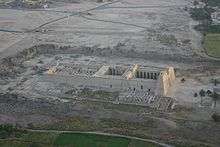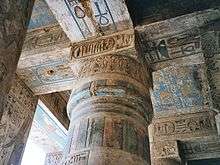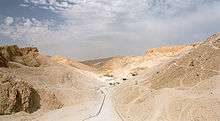Medinet Habu (location)
Medinet Habu (Arabic: مدينة هابو; Egyptian: Tjamet or Djamet; Coptic: ϫⲏⲙⲉ, ϫⲏⲙⲏ, ϫⲉⲙⲉ, ϫⲉⲙⲏ, ϫⲏⲙⲓ and ϭⲏⲙⲓ Djeme or Djemi)[1] is an archaeological locality situated near the foot of the Theban Hills on the West Bank of the River Nile opposite the modern city of Luxor, Egypt. Although other structures are located within the area, the location is today associated almost exclusively (and indeed, most synonymously) with the Mortuary Temple of Ramesses III.
| ḏꜣmwt[1][2] in hieroglyphs |
|---|
| ḏꜣmwt(t)[1] in hieroglyphs |
|---|

Temple of Amun
Just left of the entrance to the Mortuary Temple of Ramesses III is the Temple of Amun, (Ancient Egyptian: Djeser Set) dating to the 18th Dynasty, built by Hatshepsut and Thutmose III. It has undergone many alterations and modifications over the years, partially in the 20th, 25th, 26th, 29th and 30th Dynasties and the Greco-Roman period.
Temple of Ramesses III

The temple, some 150 m (490 ft) long, is of orthodox design, and closely resembles the Ramesseum. It is quite well preserved and surrounded by a massive mudbrick enclosure, which may have been fortified. The original entrance is through a fortified gate-house, known as a migdol (and resembling an Asiatic fortress).
Just inside the enclosure, to the south, are chapels of Amenirdis I, Shepenupet II and Nitiqret, all of whom had the title of Divine Adoratrice of Amun.
The first pylon leads into an open courtyard, lined with colossal statues of Ramesses III as Osiris on one side, and uncarved columns on the other. The second pylon leads into a peristyle hall, again featuring columns of Ramses III. This leads up a ramp that leads (through a columned portico) to the third pylon and then into the large hypostyle hall (which has lost its roof).
In Coptic times, there was a church inside the temple structure, but it has since been removed. Some of the carvings in the main wall of the temple have been altered by Coptic carvings.
Temple of Ay and Horemheb
Located just north of the Mortuary Temple of Ramesses III, right up to the mud-brick wall that surrounds it, lies the badly preserved Temple of Ay and Horemheb.
Gallery
Literature
- James Henry Breasted The Excavation of Medinet Habu. Volume 1 General Plans and Views. University of Chicago Press, Chicago 1934.
- Uvo Hölscher: The Excavation of Medinet Habu. University of Chicago Press, Chicago 1934–1954.
References
- Gauthier, Henri (1929). Dictionnaire des Noms Géographiques Contenus dans les Textes Hiéroglyphiques Vol. 6. pp. 105–106.
- Wallis Budge, E. A. (1920). An Egyptian hieroglyphic dictionary: with an index of English words, king list and geological list with indexes, list of hieroglyphic characters, coptic and semitic alphabets, etc. Vol II. John Murray. p. 1058.
![]()




